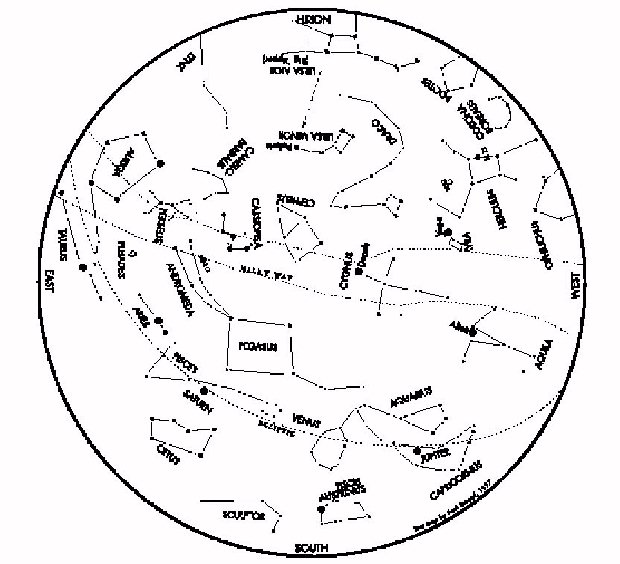

A special and rare event takes place in September. The moon will hide, or occult, the ringed planet Saturn very early on September 18. You'll need a telescope to see the details described here, but you can still see the moon creep up on brilliant Saturn, then see it suddenly snap out, as if someone turned off its light (impossible of course, since Saturn shines by reflecting sunlight). Through a telescope however, watching the moon slowly creep over the rings, then the planet, is a truly magnificent sight, and proof that Saturn is farther way than the moon! Once the planet's disk is occulted, you can see the remains of the Saturnian ring system sticking out from the dark lunar limb - a curious sight indeed, and one that is fleeting. The occultation begins shortly before 6:00 a.m. Go outside around 5:30 a.m. to give yourself time to find Saturn, which will be easily visible above the moon.
What are we seeing happen here? You will see two sky motions combined
during this event. The moon and Saturn will become lower in the western
sky as the morning wears on. This motion is caused by the daily rotation
of the Earth, which causes the stars and planets to rise and set. But notice
that the moon, in order to occult Saturn, must also be moving slowly in
the opposite direction as well, relative to Saturn and the stars - this
represents the moon's actual motion around the Earth. By watching Saturn
disappear, you are seeing the motion of the moon in its orbit around the
Earth.
Mercury - makes a brief early morning appearance. On Saturn occultation day (Sept. 18), look for Mercury on the opposite (eastern) horizon about 10 degrees above the horizon at 5:30 a.m. It is not easy to see in the bright morning twilight, however.
Venus - shines brightly though the evening twilight, lingering around the western horizon for about 90 minutes after sunset. Through a telescope it presents a gibbous phase to us, a phase that is slowly but surely shrinking. By the end of the year it will be a crescent. This changing phase of Venus is proof that it orbits the Sun inside the orbit of the Earth. No phases are visible on planets that orbit outside the Earth's orbit. Watch on September 5 for a slim crescent moon lying 3 degrees to the north of Venus, and the bright star Spica 2 degrees to the south.
Mars - By the middle of this period, at the end of September, you may notice two bright reddish objects low in the southwest, to the left of Venus. One is the red planet Mars, and the other is a star, Antares. The name Antares means "Rival of Mars." Coincidentally both are of almost identical brilliance. Antares lies on the constellation of Scorpius. During October, Mars and Venus will appear to get closer together, a line of sight effect. In viewing a plan of the solar system, you would find Mars on the far side of the solar system, and Venus much closer to Earth.
Jupiter - continues to dominates the nighttime sky in Capricornus. You'll find Jupiter rising in the southeast shortly after sunset. Find it by looking due south after the sky is dark. It is the brightest object in that region of the sky. The moon passes close by on September 13 and October 10.
Saturn - Once you've found Jupiter, look to the east, opposite
where the sun has set, and you'll find another bright point that is actually
Saturn. During the night it climbs higher above the horizon until midnight,
when it lies due south, meaning it must be opposite the sun in our sky.
Astronomers call this point "opposition," and the exact line-up occurs
on October 10.
| New Moon | 1st Quarter | Full | Last Quarter |
| Sept 1 | Sept 10 | Sept 16 | Sept 23 |
| Oct 1 | Oct 9 | Oct 16 | Oct 23 |
| Oct 31 |
On October 4 the planetarium premiers "Flashback to the Future." It's an exciting look back at the life and times of the early space age, an eclectic mix of the pop culture in the 50's and 60's, combined with the thrill and excitement of launching into space and landing on the moon.
It is 40 years since the launch of the Soviet Union's Sputnik satellite shocked the world into realizing the Space Age had arrived. Today, with landers on Mars, an orbiter around Jupiter, and a spacecraft about to be launched to Saturn, spaceflight is almost taken for granted. In the show "Flashback to the Future," we look forward to the new millennium in space and speculate where we will be in 50 years time. Check local listings for current show times.
Every Friday at 4 p.m. the Henry Buhl, Jr. Planetarium at the Carnegie Science Center presents "Stars over Pittsburgh," your weekly guide to the current night sky.
Don't forget to check new Comet Hale-Bopp images in the Planetarium show, "Comet: From Ice to Fire," running through October 3. ?
Martin Ratcliffe directs the Henry Buhl, Jr. Planetarium at Carnegie
Science Center.